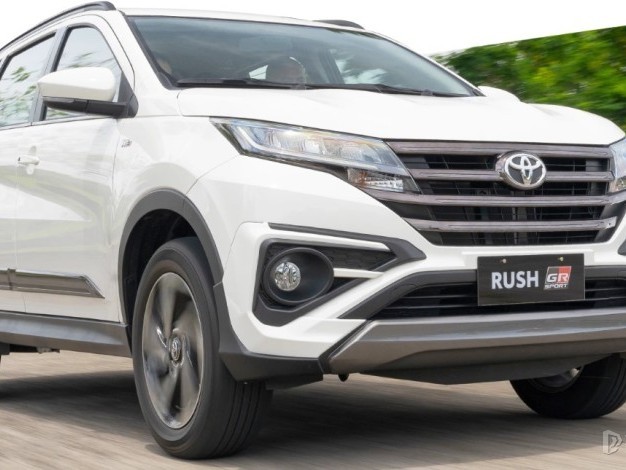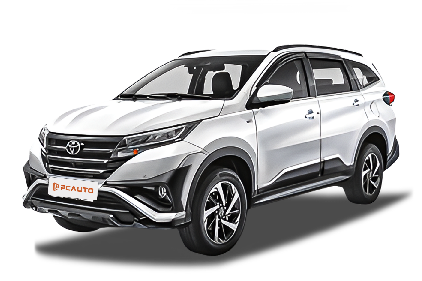Q
How fast can a Toyota Rush drive?
The Toyota Rush is powered by a naturally aspirated 1.5-liter four-cylinder gasoline engine, which produces 105 horsepower at 6,000 RPM and generates 140 Nm of torque at 4,200 RPM. It is paired with an automatic transmission and features a rear-wheel-drive layout.
While there is currently no official information regarding the Toyota Rush's top speed, considering its engine power, torque, and vehicle characteristics, it may achieve a maximum speed of approximately 160 to 180 km/h under ideal conditions. However, this is merely an estimate.
It is important to note that speeding is not only dangerous but also violates traffic regulations. The focus should be on maintaining a safe driving speed. Additionally, factors such as road conditions, vehicle load, and engine status can impact the actual attainable speed.
Special Disclaimer: This content is published by users and does not represent the views or position of PCauto.
Related Q&A
Q
Is Toyota Rush a Jeep?
The Toyota Rush is not a Jeep in the traditional sense, but rather a compact SUV built on the Toyota IMV platform, which leans more towards urban travel in the Malaysian market. This model features a higher ground clearance of approximately 220mm along with a robust and boxy exterior design, offering some light off-road capability. However, its primary focus remains on daily commuting and family use as a city-oriented SUV.
The Rush is equipped with front-wheel drive (with an optional four-wheel drive available in certain markets) and is powered by a 1.5L naturally aspirated engine (2NR-VE model) that delivers a maximum output of 104 PS. The vehicle's tuning prioritizes fuel efficiency over hard-core off-road performance. Compared to professional off-road vehicles like the Jeep Wrangler or Toyota's Land Cruiser series, the Rush lacks features such as part-time four-wheel drive and differential locks, but its compact size and nimble handling make it practical for various road conditions in Malaysia.
For users who occasionally need to tackle muddy or rocky terrain, opting for the four-wheel drive version and adding a skid plate is advisable. However, for serious off-roading, more specialized models are recommended.
Q
How many people can sit in a Toyota Rush?
The Toyota Rush can accommodate up to seven passengers. It features a 3+2+2 seating layout, which is a common configuration for seven-seater vehicles. This arrangement offers flexibility in passenger seating options. The middle row seats come with a 60:40 split-folding design, allowing for one-touch folding and manual adjustment of the incline angle, while the rear row utilizes a 50:50 split-folding design.
This versatility enables various seating configurations to cater to different needs, such as providing extra space for passengers or increasing cargo capacity. Whether you're traveling with family or friends, the seven-seat layout of the Toyota Rush offers a convenient option for group outings.
Q
Is a Toyota Rush AWD?
No, the Toyota Rush available in Malaysia is not an all-wheel drive (AWD) vehicle; it is equipped with a rear-wheel drive (RWD) system. This rear-wheel drive setup provides good balance and handling across various driving conditions. With its seven-seat layout, practical interior space, and decent off-road capability despite being RWD, the Toyota Rush has become a popular choice in the local SUV segment.
It comes with a range of safety features, including multiple airbags and electronic stability control, while the comfortable cabin layout enhances the overall driving experience. Its fuel-efficient gasoline engine and other convenient amenities cater to the needs of many local consumers.
Q
Is the Toyota Rush a CVT or automatic?
The Toyota Rush is equipped with an automatic transmission (AT), rather than a continuously variable transmission (CVT). The AT, which utilizes a hydraulic torque converter, connects to the engine and employs internal planetary gears to facilitate gear shifting and torque conversion. Both the 2019 Toyota Rush 1.5G AT and 1.5S AT feature this automatic transmission.
On the other hand, a CVT uses two variable-diameter pulleys and a steel belt to continuously and seamlessly adjust the gear ratio. The AT in the Toyota Rush offers automatic characteristics, allowing drivers to enjoy convenience without the need for manual shifting. This enhances the driving experience by making it more relaxed. Furthermore, the Rush's AT helps deliver the engine's power smoothly to the wheels, ensuring a comfortable ride. With its smooth shifting and reliable operation, the automatic transmission in the Toyota Rush meets the daily driving needs of many consumers.
Q
Is Toyota Rush expensive?
The price of the Toyota Rush ranges from RM 93,000 to RM 97,000, and whether this is considered expensive largely depends on individual perspectives and needs. For consumers on a tight budget who require a seven-seater vehicle, this price range may be quite reasonable, especially given the array of standard safety and practical features it offers, including six airbags, electronic stability control, and a 360-degree parking camera system.
From a segment perspective, this pricing is in line with the market positioning for a B-segment compact SUV. However, consumers seeking higher performance or luxury features may find it pricey, especially considering the engine produces a maximum output of 105 PS and that the majority of the seat adjustments are manual.
Q
What type of car is the Toyota Rush?
The Toyota Rush is classified as a B-segment vehicle. With a length of 4,435 mm, width of 1,695 mm, height of 1,705 mm and wheelbase of 2685mm, it features a five-door, seven-seat layout that is suitable for family use. The vehicle weighs between 1,300 and 1,305 kg, and has a fuel tank capacity of 45 liters.
Powering the Rush is a 1.5-liter gasoline engine that delivers a maximum output of 105 horsepower, paired with a rear-wheel-drive system and an automatic transmission (AT). The front suspension consists of MacPherson struts, and the braking system is equipped with ventilated disc brakes.
Safety features are extensive and include an anti-lock braking system (ABS), electronic stability control, and six airbags. Comfort features are well-appointed, with standard automatic climate control, a touchscreen infotainment system, and electric accessories. The seating configuration provides flexibility for both passengers and cargo.
Q
What is the safety rating of Toyota Rush?
The Toyota Rush excels in safety features, offering a range of equipment designed to protect both drivers and passengers. Standard active safety systems include ABS (Anti-lock Braking System), Electronic Stability Control, Lane Departure Alert, Automatic Emergency Braking, and Forward Collision Warning, all of which work together to effectively prevent accidents.
In terms of passive safety, the vehicle is equipped with six airbags, including those for the driver, front passenger, front side airbags, and curtain airbags for both front and rear passengers, providing comprehensive protection for occupants. Additionally, the ISOFIX child seat anchors offer safety and convenience for families traveling with children.
While there is no specific safety rating data available, the rich and practical safety features of the Toyota Rush suggest a high level of protection for those inside the vehicle, offering driving safety on every journey.
Q
Can a Toyota Rush go uphill?
The Toyota Rush is capable of tackling inclines with ease. It is equipped with a 1.5-liter gasoline engine that delivers a maximum power output of 105 horsepower. Under normal conditions, this level of power is sufficient to propel the vehicle uphill. Additionally, features like rear-wheel drive provide enhanced traction and stability when ascending.
The vehicle also comes standard with a Hill Start Assist feature, which prevents rollback when starting on a slope, giving drivers added confidence during incline driving. With a ground clearance of 220 millimeters, the Rush is well-equipped to handle rugged terrain without the risk of wearing the bottom. With these capabilities, the Toyota Rush is well-prepared to navigate climbing scenarios effortlessly.
Q
Is a Toyota Rush a 7-seater layout?
Yes, the Toyota Rush is a 7-seater vehicle. It features a 3+2+2 seating configuration, comfortably accommodating seven passengers. This makes it a practical choice for families or groups in need of extra seating. Compared to smaller vehicles, its seven seats provide the flexibility to transport more people.
Whether for daily commutes, road trips, or carrying larger groups, the 7-seat configuration of the Toyota Rush offers convenience and practical functionalities. Additionally, the interior design and seating arrangement are crafted to ensure sound comfort for all passengers.
Q
Which car category does Toyota Rush belong to?
The Toyota Rush falls into the B-segment compact SUV category. With a body length of 4,435 mm, a width of 1,695 mm, a height of 1,705 mm, and a wheelbase of 2685mm, it boasts a compact overall size. This model features characteristics suitable for both urban driving and light off-roading, with a minimum ground clearance of 220 mm that contributes to its good passability.
The interior is designed with a 7-seat layout, providing flexible seating options. The second row features a 60:40 split-folding design that allows for one-touch folding and manual reclining, while the third row has a 50:50 split-folding capability, catering to various passenger and cargo needs. In terms of powertrain, the Rush is equipped with a 1.5L naturally aspirated engine paired with an automatic transmission and rear-wheel drive, offering stable power support for daily commutes and occasional outdoor adventures.
Popular Cars
Model Year
Car Compare
Car Photo
Latest Q&A
Q
How much did a new 2018 beetle cost?
The 2018 Volkswagen Beetle had a starting price range of approximately RM120,000 to RM180,000, depending on the trim and options. The entry-level 1.2 TSI Design model was the most affordable, while the top-spec 2.0 TSI R-Line version approached RM180,000—though final pricing could vary with optional extras and dealer promotions.
As a timeless classic, the 2018 Beetle kept its retro charm but packed modern tech like a touchscreen infotainment system and active safety features. Under the hood, buyers could choose between the fuel-efficient 1.2T or the more spirited 2.0T engine.
Fair warning: Volkswagen discontinued the Beetle in 2019, so you’ll only find it on the used market now. That said, its iconic design and nostalgic appeal still make it a hit among collectors. If you’re eyeing a pre-owned model, always check the vehicle history and maintenance records to snag a solid deal.
Q
What engine does a 2018 VW Beetle have?
The 2018 Volkswagen Beetle offered two gasoline engine options across different markets. The primary powerplant was a 1.2-liter TSI turbocharged inline-four, delivering 105 horsepower and 175 Nm of torque, paired with a 7-speed DSG dual-clutch transmission. This compact forced-induction engine struck a balance between urban fuel efficiency and strong low-end torque.
Higher-spec variants featured an optional 1.4-liter TSI turbocharged unit, bumping output to 150 horsepower. Both engines adopted direct fuel injection and belonged to VW’s widely used EA211 modular family, featuring modern tech like lightweight aluminum blocks.
Though retaining its iconic silhouette, this generation Beetle actually shared its underpinnings with the Golf, inheriting the brand’s proven front-wheel-drive architecture. This platform commonality also translated to easier maintenance, as local dealerships were well-versed in servicing these powertrains thanks to extensive parts sharing across VW’s lineup.
Q
What are the different models of the 2018 VW Beetle?
The 2018 Volkswagen Beetle comes in three main trims: Classic, Trendline, and Sport. All models are powered by a 1.2-liter TSI turbocharged engine delivering 105 horsepower, paired with a 7-speed DSG dual-clutch transmission—perfect for city driving with its nimble handling and solid fuel efficiency.
The entry-level Classic trim rolls on 16-inch wheels and features a basic multimedia system. Stepping up to the Trendline adds 17-inch wheels, fog lights, and chrome accents. The Sport trim leans into its name with 18-inch wheels, a sport-tuned suspension, and unique interior color options.
This generation keeps the Beetle’s iconic retro curves but modernizes them with touches like LED daytime running lights. Inside, you’ll find color-matched dash panels, and with 310 liters of trunk space, it’s more practical than most small cars in its class.
Since the Beetline was discontinued in 2019, the 2018 model stands as the last new generation, making it a rising collector’s item—especially the convertible, which holds strong appeal in the used market. For maintenance, stick to routine service every 15,000 km or 12 months, and regular 95-octane fuel is all it needs.
Q
Does the 2018 Beetle have Apple CarPlay?
The 2018 Volkswagen Beetle did come equipped with Apple CarPlay, integrated into its Composition Media infotainment system. This allowed iPhone users to seamlessly connect for navigation, music, and other apps. The system also supported Android Auto, catering to different smartphone users with its intuitive and responsive interface—definitely a plus for convenience on the road.
That said, some early-production 2018 models might require a software update to activate the feature, so it’s worth checking with an official dealer to confirm your car’s specs or available upgrades. Also, wireless Apple CarPlay wasn’t standard across all trims; it depended on the factory-installed options.
For fans of classic styling who still want modern tech, the Beetle struck a nice balance between retro charm and everyday usability. Competitors like the Mini Cooper offered similar connectivity, but let’s be honest—the Beetle’s iconic design was always its standout feature.
Q
What is the fuel economy of the 2018 Beetle?
The 2018 Volkswagen Beetle's fuel efficiency varies by powertrain. The 1.2L TSI turbocharged version delivers a combined fuel consumption of around 5.5L/100km, while the 1.4L TSI model is slightly thirstier at approximately 6.0L/100km – both perform best with 95-octane petrol.
You'll likely see higher consumption in city driving, but it cruises efficiently on highways thanks to its classic aerodynamic design. For better mileage, stick to routine maintenance like cleaning the air filter and keeping tyres properly inflated. These small habits can help squeeze out extra kilometres per litre.
Though discontinued, the 2018 Beetle remains popular in the used car market – its iconic styling and decent fuel economy make it a practical daily driver. Just remember real-world figures depend heavily on driving style and road conditions, so check owner forums for real-life feedback.
View MoreRelated News

The compact SUV Toyota Rush, which has already been discontinued in Malaysia, does anyone around you drive it?
AshleyJul 25, 2024

Toyota Leads Global Sales in 2023, Despite 8% Decline but Tops Thailand
Kevin WongFeb 23, 2024

2026 Toyota HiLux receives five-star ANCAP safety rating in ANCAP
MichaelDec 12, 2025

2026 Toyota bZ4X features a larger battery and longer range but needs to be sold at a lower price
WilliamDec 12, 2025

Toyota introduces Wolfspeed SiC power semiconductors, considering their durability to be better
JohnDec 11, 2025
View More


















Pros
Cons